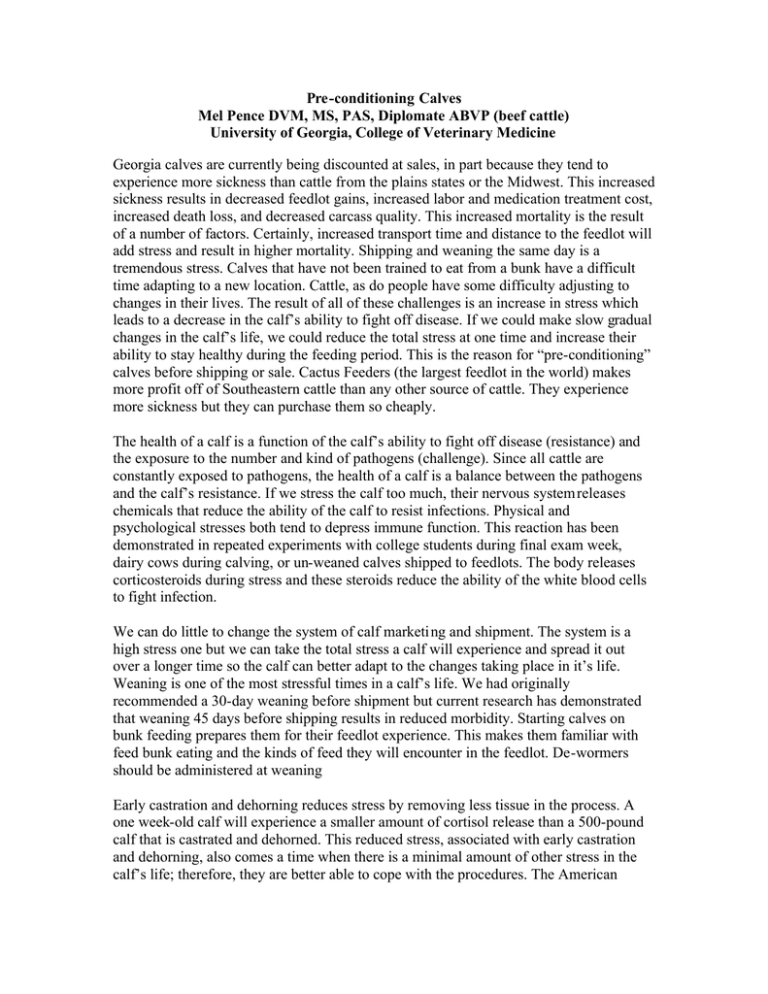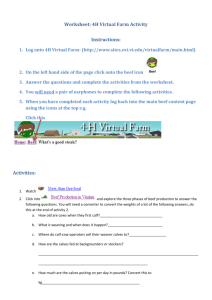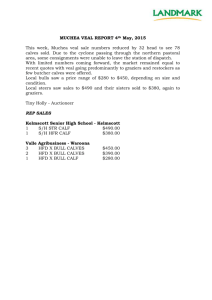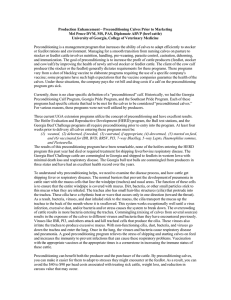Pre-conditioning Calves Mel Pence DVM, MS, PAS, Diplomate ABVP (beef cattle)
advertisement

Pre-conditioning Calves Mel Pence DVM, MS, PAS, Diplomate ABVP (beef cattle) University of Georgia, College of Veterinary Medicine Georgia calves are currently being discounted at sales, in part because they tend to experience more sickness than cattle from the plains states or the Midwest. This increased sickness results in decreased feedlot gains, increased labor and medication treatment cost, increased death loss, and decreased carcass quality. This increased mortality is the result of a number of factors. Certainly, increased transport time and distance to the feedlot will add stress and result in higher mortality. Shipping and weaning the same day is a tremendous stress. Calves that have not been trained to eat from a bunk have a difficult time adapting to a new location. Cattle, as do people have some difficulty adjusting to changes in their lives. The result of all of these challenges is an increase in stress which leads to a decrease in the calf’s ability to fight off disease. If we could make slow gradual changes in the calf’s life, we could reduce the total stress at one time and increase their ability to stay healthy during the feeding period. This is the reason for “pre-conditioning” calves before shipping or sale. Cactus Feeders (the largest feedlot in the world) makes more profit off of Southeastern cattle than any other source of cattle. They experience more sickness but they can purchase them so cheaply. The health of a calf is a function of the calf’s ability to fight off disease (resistance) and the exposure to the number and kind of pathogens (challenge). Since all cattle are constantly exposed to pathogens, the health of a calf is a balance between the pathogens and the calf’s resistance. If we stress the calf too much, their nervous system releases chemicals that reduce the ability of the calf to resist infections. Physical and psychological stresses both tend to depress immune function. This reaction has been demonstrated in repeated experiments with college students during final exam week, dairy cows during calving, or un-weaned calves shipped to feedlots. The body releases corticosteroids during stress and these steroids reduce the ability of the white blood cells to fight infection. We can do little to change the system of calf marketing and shipment. The system is a high stress one but we can take the total stress a calf will experience and spread it out over a longer time so the calf can better adapt to the changes taking place in it’s life. Weaning is one of the most stressful times in a calf’s life. We had originally recommended a 30-day weaning before shipment but current research has demonstrated that weaning 45 days before shipping results in reduced morbidity. Starting calves on bunk feeding prepares them for their feedlot experience. This makes them familiar with feed bunk eating and the kinds of feed they will encounter in the feedlot. De-wormers should be administered at weaning Early castration and dehorning reduces stress by removing less tissue in the process. A one week-old calf will experience a smaller amount of cortisol release than a 500-pound calf that is castrated and dehorned. This reduced stress, associated with early castration and dehorning, also comes a time when there is a minimal amount of other stress in the calf’s life; therefore, they are better able to cope with the procedures. The American Association of Bovine Practitioners and the National Cattlemen’s Beef Association have recommended that all calves be dehorned and castrated as early in life as possible. In addition to reducing stress, we can also increase resistance to disease by vaccinations. The ideal time to vaccinate is between four and six months. Calves should be vaccinated for 7-way Blackleg, IBR, PI3, BVD, BRSV, and Pasteurella. These are the most common pathogens that calves will be exposed to as they enter the feedlot. By timing the stresses in a calf’s life to reduce the total stress at any one time and increasing it’s immunity to likely pathogens we will increase the ability of calves to gain efficiently and produce a high quality carcass. Preconditioning can benefit both the producer and the purchaser of the cattle. By preconditioning calves, you can make it easier for them to adapt to stresses they might encounter at the feedlot. As a result, you can avoid the $40 to $90 per head costs associated with treating sick cattle, the weight loss, and reduction in carcass value that may occur. These procedures will enhance our Georgia product and benefit the entire beef industry. The procedures may become part of a source verified beef quality assurance program or a certified animal welfare program. Compliance with these preconditioning procedures and certification programs will help assure that you have market access for your calves.





